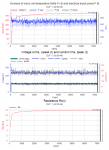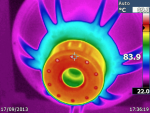Hey Jimmy,
I think if it takes 8 minutes for the video to explain it, they are being too complicated

My rule of thumb is like this:
- What's the biggest amplifier I can get my hands on? Use that.
- Use a long term RMS power limiter (preferably built in) to limit to 1/2 rated AES power (whatever the lowest power on the woofer spec sheet is).
- Use a proper HPF set at approximately the loudspeaker's tuning frequency.
For most PA cabinets this works, in other designs that do not control excursion well or have unusually low tunings you may run out of excursion sooner than you'd like. In general I find that for modern woofers I can't get an amplifier large enough to satisfy my peak power desires, I'd like no less than 2x AES power (often labeled "Program") and 4x (often labeled "peak) would be better. You can pretty much assume 12dB peak to average in audio, round down to 10dB and that means I need a 5,000 "watt" amp for my 500 "watt" woofer. YMMV, but I don't see many toasted woofers - except in circumstances where the power capacity was actually lower than expected for some reason.
Here is an article I wrote a while back on this subject:
http://www.bennettprescott.com/downloads/LoudspeakerFundamentals.pdf



